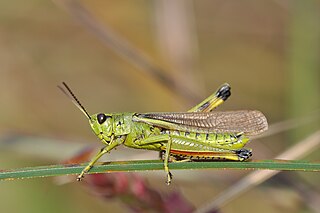
Orthoptera is an order of insects that comprises the grasshoppers, locusts, and crickets, including closely related insects, such as the bush crickets or katydids and wētā. The order is subdivided into two suborders: Caelifera – grasshoppers, locusts, and close relatives; and Ensifera – crickets and close relatives.

The river warbler is an Old World warbler in the grass warbler genus Locustella. It breeds in eastern and central Europe, and into the western Palearctic. It is migratory, wintering in inland southern Africa, from around the Zambezi River south to the vicinity of Pretoria in South Africa. The genus name Locustella is from Latin and is a diminutive of locusta, "grasshopper". This refers to the song of the common grasshopper warbler and some others in this genus. The specific fluviatilis is Latin for "of a river".

Grasshoppers are a group of insects belonging to the suborder Caelifera. They are among what is possibly the most ancient living group of chewing herbivorous insects, dating back to the early Triassic around 250 million years ago.

Acrididae, commonly called short-horned grasshoppers, are the predominant family of grasshoppers, comprising some 10,000 of the 11,000 species of the entire suborder Caelifera. The Acrididae are best known because all locusts are of the Acrididae. The subfamily Oedipodinae is sometimes classified as a distinct family Oedipodidae in the superfamily Acridoidea. Acrididae grasshoppers are characterized by relatively short and stout antennae, and tympana on the side of the first abdominal segment.

The Caelifera are a suborder of orthopteran insects. They include the grasshoppers and grasshopper-like insects, as well as other superfamilies classified with them: the ground-hoppers (Tetrigoidea) and pygmy mole crickets (Tridactyloidea). The latter should not be confused with the mole crickets (Gryllotalpidae), which belong to the other Orthopteran sub-order Ensifera.

Tropidoclonion is a genus of snake in the subfamily Natricinae of the family Colubridae. The genus is monotypic, containing the sole species Tropidoclonion lineatum, commonly known as the lined snake. The species is endemic to North America.

Mendosoma lineatum, the telescope fish, real bastard trumpeter or common trumpeter, is a species of marine ray finned fish belonging to the family Latridae, the trumpeters. It is native to the subantarctic and cooler temperate waters of the Southern Ocean. It inhabits tide pools and surge channels and has been found living inside such invertebrates as salps. It occurs from near the surface to a depth of about 20 metres (66 ft). This species can reach a length of 40 centimetres (16 in) TL. This species was thought to be the only known member of its genus.

The rufescent tiger heron is a species of heron in the family Ardeidae. It is found in wetlands from Central America through much of South America.

The large hawk-cuckoo is a species of cuckoo in the family Cuculidae. It has a wide breeding distribution from temperate Asia along the Himalayas extending to East Asia. Many populations winter further south. They are known for their loud and repetitive calls which are similar to that of the common hawk-cuckoo but do not rise in crescendo. They are also somewhat larger and adults can be readily told apart from the smaller common hawk-cuckoo by the black patch on the chin. They are brood-parasites of babblers and laughing-thrushes.

The streaked laughingthrush is a species of bird in the family Leiothrichidae. It is commonly found in the northern regions of the Indian subcontinent and some adjoining areas, ranging across Afghanistan, Bhutan, India, Nepal, Pakistan, Russia, and Tajikistan.
Streptocarpus lineatus, synonym Nodonema lineatum, is a species of plant in the family Gesneriaceae. It is found in Cameroon and Nigeria. Its natural habitat is subtropical or tropical moist lowland forests. It is threatened by habitat loss.

Rhagium is a genus of flower longhorn beetles in the family Cerambycidae, Cerambycidae.

Mendosoma is a genus of marine ray finned fish belonging to the family Latridae, the trumpeters.

Stethophyma is a genus of grasshoppers in the family Acrididae, with species found in Europe, North America and Japan.

The large marsh grasshopper is a species of grasshopper belonging to the family Acrididae.

Trypodendron lineatum, known generally as striped ambrosia beetle, is a species of typical bark beetle in the family Curculionidae. Other common names include the two-striped timber beetle, conifer ambrosia beetle, and spruce timber beetle. It is found in Europe and North America.

Melapium lineatum is a species of sea snail, a marine gastropod mollusk in the family Strepsiduridae.

Stethophyma gracile, known generally as the graceful sedge grasshopper or northern sedge grasshopper, is a species of band-winged grasshopper in the family Acrididae. It is found in North America.
















